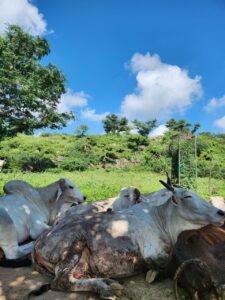The Goal is Not Ahimsa – The Goal is Love
Ahimsa, often translated as non-violence, is a profound principle. Its aim is to minimize suffering in the world. But is that enough?
Ahimsa is only the beginning—a foundational step. Just as watering the roots of a tree nourishes all its leaves and branches, aspiring to and cultivating love for Krishna enables us to love all. The ultimate goal is not simply to avoid causing harm but to spread transcendental love and joy. Ahimsa, in its highest form, transforms into the positive action of sharing divine love.
Understanding Ahimsa
Srila Prabhupada, the founder Acharya of ISKCON, in Bhagavad-gita (13.8-12purport) stated
“Nonviolence is generally taken to mean not killing or destroying the body, but actually nonviolence means not to put others into distress. People in general are trapped by ignorance in the material concept of life, and they perpetually suffer material pains. So unless one elevates people to spiritual knowledge, one is practicing violence. One should try his best to distribute real knowledge to the people, so that they may become enlightened and leave this material entanglement. That is nonviolence.”

Radhanath Swami, in his book The Journey Within, writes:
“The first regulative principle [in Sanskrit—yama], ahimsa, is nonviolence, to cause no harm to any living being through our actions, words, and, as far as humanly possible, our thoughts. This will protect us from accruing negative karma, which only further covers the self. The Bhagavad-gita teaches that a Yogi sees the Divine in the heart of all beings and therefore wishes all beings well. Compassion is the basis of ahimsa.”
This deep sense of compassion motivates bhakti-yogis to choose a vegetarian lifestyle. Animals, like humans, experience pain and emotions. As Sadhu Vaswani eloquently said:
“All killing is a denial of love... Cruelty hardens our hearts and blinds our vision to the reality that those whom we kill are our brothers and sisters in the One Brotherhood of Life.”
Ahimsa is not just about refraining from harm. It’s about nurturing a spirit of respect and care for all life.
Bhakti Yoga: Beyond Non-Violence
At TH3 LOT, our journey is one of realizing our spiritual nature and achieving higher consciousness. Bhakti-yoga guides us to live in harmony with the world while awakening our relationship with the divine.
In addition to spiritual practices like mantra meditation (japa), bhakti-yogis strive to cultivate good character and renounce habits that degrade consciousness. Among these habits, embracing ahimsa is fundamental.
Yet, the goal extends beyond refraining from harm. Through positive action—spreading love, sharing prasadam, and serving others—we create a culture of divine joy.
Prasadam: The Practical Application of Ahimsa
One of the ways we practice and share ahimsa at TH3 LOT is by distributing Krishna prasadam in and around the villages of Mayapur. Prasadam, sanctified food offered with love to Krishna, embodies the essence of compassion and divine love.
We hope your interest in spirituality has inspired you to consider a meatless (ahimsa) diet. But remember, ahimsa is only a stepping stone. Through positive acts of service and love, we aim to manifest a world where non-violence naturally flourishes as a by-product of our existence.
A Universal Call to Action
Let us not stop at avoiding harm. Let us take the next step—toward love. Share prasadam, offer kindness, and nurture a culture of service. Together, we can make the world a place where divine love touches every heart.
